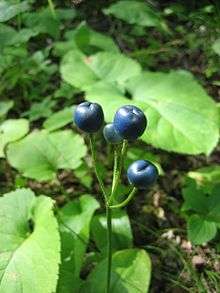Clintonia
| Bead Lilies: Clintonia | |
|---|---|
 | |
| Clintonia borealis | |
| Scientific classification | |
| Kingdom: | Plantae |
| (unranked): | Angiosperms |
| (unranked): | Monocots |
| Order: | Liliales |
| Family: | Liliaceae |
| Subfamily: | Medeoloideae |
| Genus: | Clintonia Raf. 1818 not Douglas ex Lindl. 1829 (syn of Downingia in Campanulaceae)[1] |
| Synonyms[2] | |
| |
Clintonia is a genus of flowering plants first described as a genus in 1818.[3][4] It is distributed across North America and eastern Asia[2] where it is found as an understory plant in woodlands. It was named after De Witt Clinton, an 18th-century botanist and U.S. politician.[5]
Description
Clintonia species are herbaceous perennials growing from rhizomatous underground stems with thin, fibrous roots. They grow from 1.5 to 8 dm tall. They have 2 to 6 basal leaves arising from the rhizome crown, the basal leaves are sessile and sheathing, and the cauline leaves have a stalk, the blade of the leaves have a prominent central vein and entire margins, and the bottom ends are obovate to oblanceolate in shape. The leaf apex is acute to abruptly short-acuminate, often mucronate (ending abruptly in a short sharp point). The inflorescences are terminal, and the flowers are arranged into short racemes or umbel-like clusters, with 1 to 45 flowers. The flowers have 6 tepals with nectaries present. The stamens are inserted at the base of the perianth, and the anthers are oblong-obovate to oblong-linear shaped. The rounded to cylinder shaped ovary is superior with two chambers (sometime three). Each chamber produces 2 to 10 ovules. The smooth fruits are berry-like, round to egg-shaped, metallic blue to black in color. Four to thirty seeds are produced in each fruit and the seeds are shiny brown, round and the ends are angled with 2 or 3 faces.[6][7]
Species
- C. andrewsiana - SW Oregon, W California
- C. borealis - E Canada, NE USA, Great Lakes, Appalachians
- C. udensis - China, Korea, Japan, Myanmar, Himalayas, Russian Far East
- C. umbellulata - Appalachians
- C. uniflora - western North America from Alaska to California
Cultivation
Clintonia species are cultivated as garden subjects in shade gardens, grown for the glossy foliage, small lily-like flowers, and blue fruits, and their ability to live in heavy shade. They grow best in cool, organic-rich, acid soils that retain moisture and when grown well form dense slowly spreading clumps.[9]
References
- ↑ The Plant List, Clintonia elegans Douglas ex Lindl.
- 1 2 3 Kew World Checklist of Selected Plant Families
- ↑ Rafinesque, Constantine Samuel. 1818. American monthly magazine and critical review 2: 266
- ↑ Tropicos, Clintonia Raf.
- ↑ Umberto Quattrocchi (3 May 2012). CRC World Dictionary of Medicinal and Poisonous Plants: Common Names, Scientific Names, Eponyms, Synonyms, and Etymology (5 Volume Set). CRC Press. pp. 1024–. ISBN 978-1-4200-8044-5.
- ↑ Flora of North America, Clintonia Rafinesque
- ↑ Flora of China Vol. 24 Page 150 七筋菇属 qi jin gu shu Clintonia Rafinesque, Amer. Monthly Mag. & Crit. Rev. 2: 266. 1818.
- ↑ Biota of North America Program 2013 county distribution maps
- ↑ William Cullina (2000). The New England Wild Flower Society Guide to Growing and Propagating Wildflowers of the United States and Canada. Houghton Mifflin Harcourt. pp. 78–. ISBN 0-395-96609-4.
External links
| Wikispecies has information related to: Clintonia |
| Wikimedia Commons has media related to Clintonia. |
